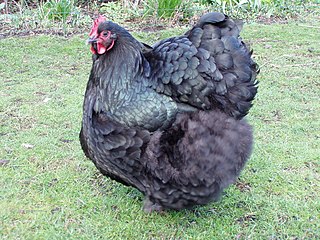
The Orpington is a British breed of chicken. It was bred in the late nineteenth century by William Cook of Orpington, Kent, in south-east England. It was intended to be a dual-purpose breed, to be reared both for eggs and for meat, but soon became exclusively a show bird.

The Cochin is a breed of large domestic chicken. It derives from large feather-legged chickens brought from China to Europe and North America in the 1840s and 1850s. It is reared principally for exhibition. It was formerly known as Cochin-China.
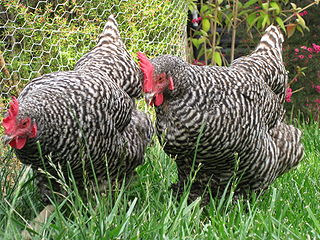
The Plymouth Rock is an American breed of domestic chicken. It was first seen in Massachusetts in the nineteenth century and for much of the early twentieth century was the most widely kept chicken breed in the United States. It is a dual-purpose bird, raised both for its meat and for its brown eggs. It is resistant to cold, easy to manage, and a good sitter.

Indian Runners are a breed of Anas platyrhynchos domesticus, the domestic duck. They stand erect like penguins and, rather than waddling, they run. The females usually lay about 300 to 350 eggs a year or more, depending whether they are from exhibition or utility strains. They were bred on the Indonesian islands of Lombok, Java and Bali where they were 'walked' to market and sold as egg-layers or for meat. These ducks do not fly and only rarely form nests and incubate their own eggs. They run or walk, often dropping their eggs wherever they happen to be. Duck-breeders need to house their birds overnight or be vigilant in picking up the eggs to prevent them from being taken by other animals.

The Wyandotte is an American breed of chicken developed in the 1870s. It was named for the indigenous Wyandot people of North America. The Wyandotte is a dual-purpose breed, kept for its brown eggs and its yellow-skinned meat. It is a popular show bird, and has many color variants. It was originally known as the American Sebright.

The Campbell is a British breed of domestic duck. It was developed at Uley, in Gloucestershire, England, at the turn of the 20th century; being introduced to the public in 1898 and the Khaki variety in 1901.
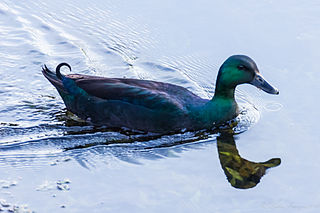
The Cayuga is an American breed of domestic duck. It was introduced to the Finger Lakes region of New York State in about 1840, and is named for the Cayuga people of that area. Until the last years of the nineteenth century it was the principal duck reared for meat in the United States. In the twenty-first century it is kept mainly for ornament.
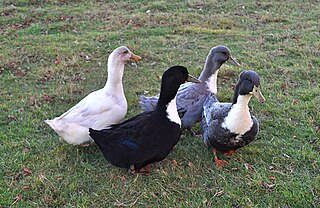
The Swedish Blue or Blue Swedish is a Swedish breed of domestic duck. It emerged during the nineteenth century in what was then Swedish Pomerania, located in present-day north-east Germany.

The Rouen is a heavyweight breed of domesticated duck. Rouens are raised primarily for meat, exhibition, or as general purpose ducks. Since they are not prolific egg layers, Rouen ducks are most commonly bred for their meat. The breed originated in France sometime before the 19th century.

The Call is a historic breed of small domestic duck. It is believed to have originated in the Netherlands, where the earliest descriptions and depictions of it date from the seventeenth century. It is similar in appearance to some other breeds of duck, but is much smaller, with a round head and very short bill. Ducks, but not drakes, are very loquacious and noisy, with a piercing high-pitched call which be heard from far away.

The Orpington or Buff Orpington Duck is a breed of domestic duck. It is a dual-purpose breed used for meat and egg production. It is capable of laying up to 220 eggs a year. Originally created by William Cook of Orpington, Kent, England, from the selection of mis-marked Blue Orpington Ducks; Cook was also the developer of the Orpington chicken. The breeds used in the development of the breed included Cayuga, Indian Runner, commercial Aylesbury and Rouen. It is proposed that Cook's intentions for the breed were to capitalize on the growing demand for the buff colour pattern. The Buff Orpington Duck was introduced to the public at the Dairy Show, the Agricultural Hall (q.v.), Islington, London in October 1897. It is considered a threatened breed by the ALBC. This breed was admitted to the British Poultry Standard in 1910 and the American Poultry Associations Standard of Perfection as the 'Buff Duck' in the Medium class in 1914. The Orpington duck is available in three colour varieties: Buff, Blond and Brown. The Buff Orpington is an unstable colour due to a blue dilution gene which means that from the offspring, all three colour variations will appear.

The Magpie is a British breed of domestic duck. It has distinctive black and white markings reminiscent of the European magpie, and is a good layer of large eggs.

The Buckeye is an American breed of chicken. It was created in Ohio in the late nineteenth century by Nettie Metcalf. The color of its plumage was intended to resemble the color of the seeds of Aesculus glabra, the Ohio Buckeye plant for which the state is called the 'Buckeye State'.
The Nankin Bantam or Nankin is a British bantam breed of chicken. It is a true bantam, a naturally small breed with no large counterpart from which it was miniaturised. It is of South-east Asian origin, and is among the oldest bantam breeds. It is a yellowish buff colour, and the name is thought to derive from the colour of nankeen cotton from China.

The Silver Appleyard is a British breed of domestic duck. It was bred in the first half of the twentieth century by Reginald Appleyard, with the aim of creating a dual-purpose breed that would provide both a good quantity of meat and plenty of eggs.

The Pomeranian goose, also known as the Rügener goose, is a breed of domestic goose.
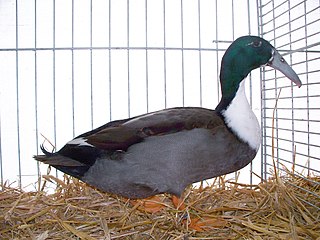
The Hook Bill or Dutch Hookbill is a breed of domestic duck characterised by an unusual down-curved beak. It is an ancient breed, and has been documented since the seventeenth century. Speculation that it originated in Asia, or is related to the Indian Runner, is apparently unsubstantiated.

The Welsh Harlequin is a breed of domestic duck originating in Wales. In 1949, in Criccieth, Group Captain Leslie Bonnet discovered a colour mutation among his flock of Khaki Campbells and began selective breeding for the trait. By 1968, hatching eggs were exported to the United States, followed by the importation of live birds in 1981.

The Golden Cascade is a breed of domestic duck developed in the United States. In 1979, David Holderread of Corvallis, Oregon set out to breed a duck that was fast growing, active, laid eggs well, and was auto-sexing. By the mid-1980s, the Golden Cascade was introduced to the market. It is not yet admitted to the American Poultry Association's Standard of Perfection.

The German Pekin, German: Deutsche Pekingente, is a European breed of domestic duck. It is commonly called simply Pekin or White Pekin. It is a different breed from the American Pekin, which is also commonly known by the same names. It was bred in Europe from birds originating in China and Japan and is distributed in many European countries.






















